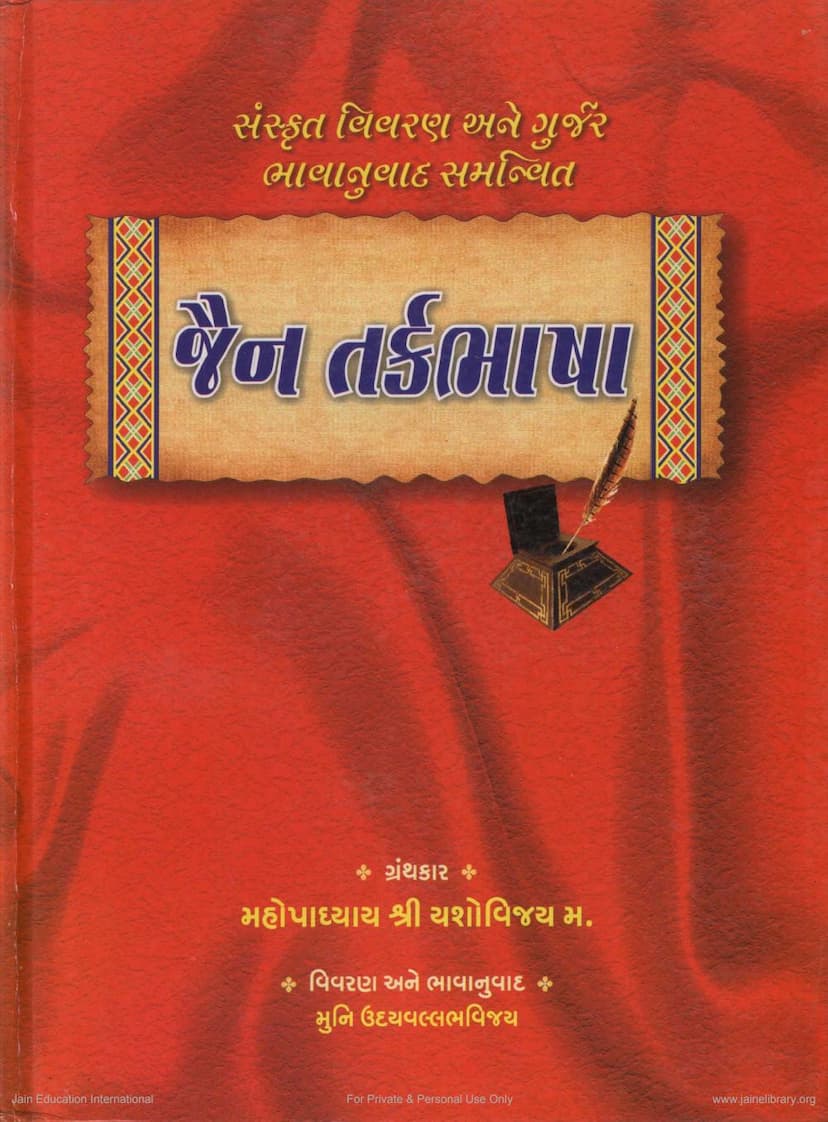Jain Tarkabhasha
Added to library: September 2, 2025

Summary
Here's a comprehensive summary of the Jain text "Jain Tarkabhasha," based on the provided Gujarati text:
Book Title: Jain Tarkabhasha (જૈન તર્કભાષા) Author: Mahamahopadhyaya Yashovijayji (મહોપાધ્યાય શ્રી યશોવિજયજી) Commentary/Translation: Muni Udayvallabh Vijayji (મુનિ શ્રી ઉદયવલ્લભવિજયજી) Publisher: Divya Darshan Trust (દિવ્યદર્શન પ્રકાશન ટ્રસ્ટ)
Overall Purpose and Significance:
"Jain Tarkabhasha" is a foundational Jain text authored by the renowned philosopher Mahamahopadhyaya Yashovijayji. The book aims to provide a clear and accessible introduction to the core principles of Jain logic and epistemology for students. The commentary and Gujarati translation by Muni Udayvallabh Vijayji further enhance its usability by making complex philosophical concepts understandable, even for beginners. The text focuses on the crucial elements of Jain philosophy: Pramana (Valid Means of Knowledge), Nay (Standpoints), and Nikshepa (Categorization).
Key Concepts and Structure:
The book is structured into three main sections (Parichhedas):
-
Pramana Parichhed (प्रमाणपरिच्छेद): This section deals with the valid means of knowledge in Jainism.
- Definition of Pramana: The text defines Pramana as "knowledge that correctly ascertains the self and the other" (स्वपरव्यवसायि ज्ञानं प्रमाणम्). It emphasizes the accurate apprehension of reality.
- Classification of Pramana: Jainism primarily recognizes two means of valid knowledge:
- Pratyaksha (प्रत्यक्ष - Direct Perception): This is knowledge directly derived from sensory perception or internal perception. The text elaborates on its different types:
- Savyaavahaarika Pratyaksha (सांव्यवहारिक प्रत्यक्ष - Conventional Direct Perception): This refers to the perceptual knowledge obtained through the senses (like sight, sound) and mind. It is further divided into types based on the five senses and mind. The text discusses the subtle aspects of sensory perception, including the process of Avagraha (initial perception), Eeha (inquiry), Avaya (definite perception), and Dharana (retention).
- Paaramaarthika Pratyaksha (पारमार्थिक प्रत्यक्ष - Absolute Direct Perception): This refers to the direct knowledge possessed by omniscient beings (Kevalins). It is classified into Avadhi (limited clairvoyance), Manahparyaya (telepathy), and Keval-gyana (absolute omniscience). The text describes these as pure, unhindered knowledge.
- Paroksha (परोक्ष - Indirect Knowledge): This is knowledge derived through inference, testimony, or memory. The text discusses:
- Smriti (स्मृति - Memory): Recollection of past experiences.
- Pratyabhijna (प्रत्यभिज्ञान - Recognition): Recognizing something based on past memory and present perception.
- Tarka (तर्क - Reasoning/Logic): Inferential reasoning based on observed correlations and logical deduction.
- Anumana (अनुमान - Inference): Drawing conclusions based on established relationships (like smoke indicating fire). The text explains the process of Anumana, including the concepts of Paksha (proposition), Hetu (reason), Sadhya (predicate), and the various fallacies (Hetvabhasas).
- Agama (आगम - Testimony/Scriptural Authority): Valid knowledge derived from the teachings of omniscient beings (Tirthankaras) and their enlightened disciples.
- Pratyaksha (प्रत्यक्ष - Direct Perception): This is knowledge directly derived from sensory perception or internal perception. The text elaborates on its different types:
- Critique of Other Schools: The text also briefly addresses and refutes the epistemological views of other philosophical schools (like Buddhism, Mimamsa, Nyaya) to establish the validity and superiority of the Jain perspective.
-
Naya Parichhed (नयपरिच्छेद): This section explains the concept of Nay, which refers to subjective standpoints or perspectives through which reality is understood.
- Definition of Nay: Nays are described as cognitive processes that grasp a specific aspect or part of an object, without negating other aspects. They are essential for understanding the multifaceted nature of reality.
- Dravyaarthika Nay (द्रव्यार्थिक नय): This standpoint focuses on the substance or underlying reality, which is eternal and unchanging. It prioritizes the "what it is" aspect.
- Paryaayaarthika Nay (पर्यायार्थिक नय): This standpoint focuses on the modes, states, or attributes of a substance, which are transient and ever-changing. It prioritizes the "how it is" aspect.
- Classification of Nays: The text details the seven main Nays, often categorized under Dravyaarthika and Paryaayaarthika, with subtle distinctions:
- Dravyaarthika Nays:
- Naigama (नैगम): The most comprehensive nay, considering both general and specific aspects, and often synthesizing different perspectives.
- ** Sangraha (सङ्ग्रह):** Focuses on the universal or general aspect of things, often overlooking specifics.
- Vyavahaara (व्यवहार): Focuses on the conventional or worldly perspective, often dealing with particulars and practical realities.
- Paryaayaarthika Nays:
- Rijusutra (ऋजुसूत्र): Focuses on the present moment and the immediate aspect of reality.
- Shabda (शब्द): Analyzes the meaning based on linguistic conventions and usage.
- Samabhirudha (समभिरूढ): Examines the meaning based on grammatical analysis and the intended meaning of word usage.
- Evambhuta (एवम्भूत): Focuses on the state or condition in which something exists or acts at a particular time.
- Dravyaarthika Nays:
- Nayaabhasas (नयाभास): The text also touches upon distorted or mistaken standpoints (Nayaabhasas) that lead to incomplete or erroneous conclusions.
-
Nikshepa Parichhed (निक्षेपपरिच्छेद): This section explains Nikshepa, a system of categorization used in Jainism to analyze concepts and entities.
- Definition of Nikshepa: Nikshepa is a method of classifying or analyzing phenomena to understand them from various angles.
- Four Main Nikshepas:
- Naama (नाम): Categorization based on designation or name.
- Sthaapanaa (स्थापना): Categorization based on representation or installation (e.g., an idol representing a deity).
- Dravya (द्रव्य): Categorization based on substance or potentiality.
- Bhaava (भाव): Categorization based on the actual state or mode.
- Application: The text illustrates how these Nikshepas are applied to understand concepts like "Jiva" (soul) and how different Nays interpret these Nikshepas.
Commentary and Translation:
Muni Udayvallabh Vijayji's contribution is vital in making Yashovijayji's potentially dense philosophical work accessible. The commentary (Vivarana) and Gujarati translation (Bhavanuvaad) break down the original Sanskrit verses, explain the intricate logical arguments, and provide context, making the "Jain Tarkabhasha" a valuable resource for students of Jain philosophy.
Overall Contribution:
The "Jain Tarkabhasha" serves as a crucial text for understanding Jain epistemology and logic. It systematically explains how knowledge is acquired, the different perspectives through which reality can be viewed, and the methods of classification and analysis. The commentary by Muni Udayvallabh Vijayji ensures that the profound insights of Mahamahopadhyaya Yashovijayji are available to a wider audience, contributing significantly to Jain education and philosophical discourse.